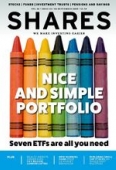Archived article
Please note that tax, investment, pension and ISA rules can change and the information and any views contained in this article may now be inaccurate.
US markets flash warning signs with echoes of past corrections

Technical analysis and other market developments suggest investors should be on their guard.
Both the S&P 500 and Nasdaq 100 indices are rising at the same time as implied volatility is rising – a phenomenon known as positive correlation – which is not only highly unusual but typically presages a sharp correction in prices.
Put simply, implied volatility normally rises when markets fall as investors see a risk of prices falling further. Last week both the S&P 500 and the CBOE VIX volatility index moved up together, as did the Nasdaq 100 index and the VXN volatility index.
Typically when stocks fall, demand for sell or ‘put’ options spikes as investors try to buy downside protection and the volatility or ‘fear’ gauges go up.
This time it may be that investors, caught in an upside panic by the continuing rise of both indices, are instead buying ‘call’ options which is pushing up the volatility gauges.
However, the last time this positive correlation happened in late 2018, stocks not just in the US but around the world fell more than 20% over the following three months. The same also happened in 2015 and 2007.
Another worrying factor is the record low in short positions as this year’s 50%-plus rally in the S&P from its March lows has left bears nursing heavy losses. According to Goldman Sachs, short interest as a proportion of market value for the median S&P 500 stock is just 1.8%, the lowest since the bank began tracking the data in 2004.
At the same time, speculative buying of stocks and ETFs has exploded among inexperienced millennial and ‘generation Y’ traders with the advent of unlimited, commission-free trading via apps such as Robinhood which offer real-time pricing and fractional investing.
These traders don’t come into the market ‘hampered by the heavy armour of tradition, but with a vision for the future and boundless hope and optimism’ to quote economist John Kenneth Galbraith.
Similarly, the proliferation of special purpose acquisition companies (Spacs) – of which more have listed already this year than in the whole of last year – is reminiscent of the investment companies which sprung up on Wall Street in the 1920s before the crash in 1929, and long before that in the coffee shops of London in the final stages of the South Sea Bubble. Students of history, and investors everywhere, should take note.
A put option enables an investor to sell an asset at an agreed price on or before a particular date. A call option is the same apart from the investor agrees to buy the asset.
Important information:
These articles are provided by Shares magazine which is published by AJ Bell Media, a part of AJ Bell. Shares is not written by AJ Bell.
Shares is provided for your general information and use and is not a personal recommendation to invest. It is not intended to be relied upon by you in making or not making any investment decisions. The investments referred to in these articles will not be suitable for all investors. If in doubt please seek appropriate independent financial advice.
Investors acting on the information in these articles do so at their own risk and AJ Bell Media and its staff do not accept liability for losses suffered by investors as a result of their investment decisions.
Issue contents
Editor's View
Feature
First-time Investor
Great Ideas
Money Matters
News
- Saga white knight welcomed by investors
- SDL’s tie-up with RWS offers a compelling story
- Shock resignation of Japan PM hits Nikkei
- US markets flash warning signs with echoes of past corrections
- US Federal Reserve tweaks monetary policy goals
- Beauty website owner prepares for biggest London listing of 2020

 magazine
magazine










